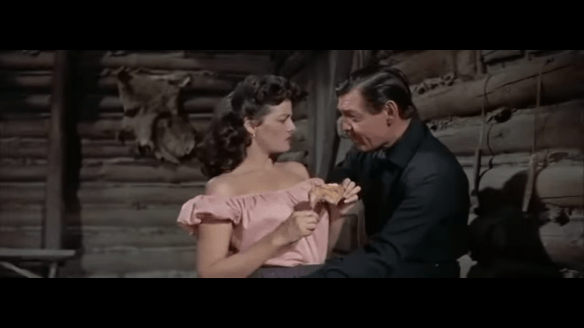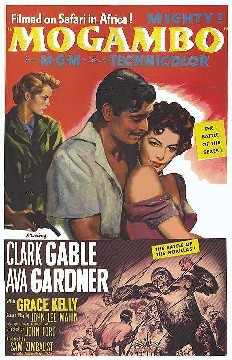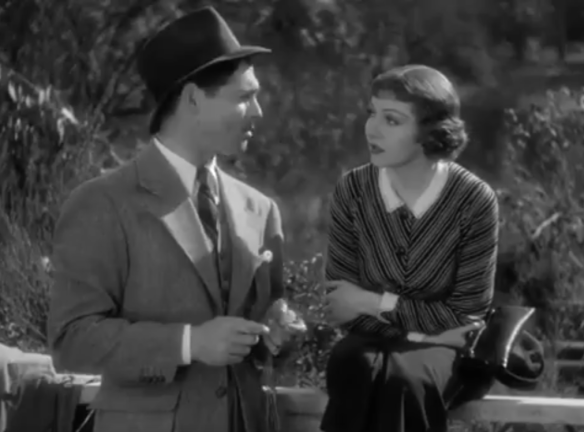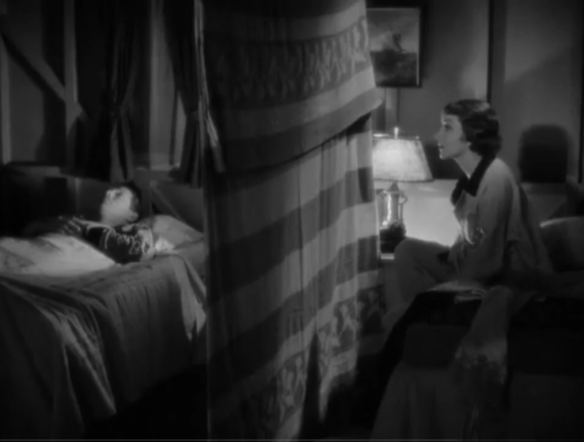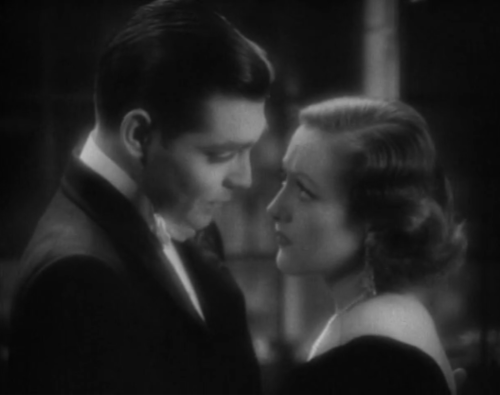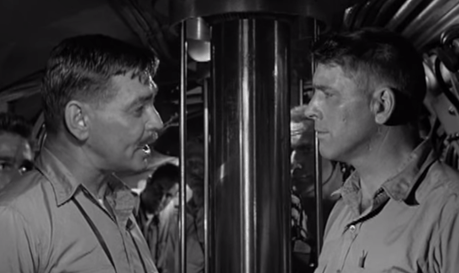We open in Montana 1866 with the Allison brothers (Clark Gable and Cameron Mitchell), two former Confederate soldiers, leaving behind the “heartbreak memory of Gettysburg” for the promise of wealth in California. But first they must traverse frostbitten exteriors.
It’s no picnic as they join forces with Robert Ryan and face a treacherous trail overtaken by blizzard conditions. It chills your bones just watching them wade through the snow, fighting against the icy landscape.
When Jane Russel gets into the picture, the story and the dialogue start to pick up. She always had a way with words — and meeting in a snowstorm has a way of bringing folks together — she’s quickly trading repartee with first Gable and then Mitchell. Ryan just sits by and lets them have at it.
Gable and Russell end up in a cabin together out of the cold. It’s not quite the “Walls of Jericho,” but as Gable cooks up some meat over the fire, and she warms her feet on his back with a few playful kicks, the moment becomes the highlight of the picture thus far. We understand and appreciate the human connection unfolding before us going beyond dialogue or plot points even the nature outside. It’s about two people connecting with one another in a movie but also as individual performers.
In fact, I liked it all very much until I realized I was being imposed upon by a story and a plot. The characters are forced apart and spend the night pouting in their separate corners. It feels like a cheap rom-com ploy in a movie that might have been about something far more gripping and substantive. Instead, it becomes a feeble excuse to inject some amount of tension into the picture.
Sadly, it’s never able to reignite the same alluring lightheartedness of their opening introduction. They’re too busy trying to be distraught with one another to make time for much fun. In this way, Raoul Walsh is not Howard Hawks.
Ryan is frankly subdued if fairly determined with what he wants, be it cattle driving, making money, or charming the women he keeps company with. In his own quiet, self-assured way, he’s out for status and remains the envy of every other man. He can never be mistaken for a villain or even a real rival for Gable. They never play it that way. Even when his hot-headed brother, played by Mitchell gets belligerent, Gable’s quick to defuse the situation.
There’s also little push or purpose to the ensuing cattle drive as it is more of a conduit for the romantic tension, and it hardly seems to be enough to carry the weight of such a lengthy picture. Jane Russell is given ample opportunity to sing, bathe herself, and remove her stockings for the camera. Whatever the contemporary audience might have clamored for, it’s a sorry use for her talents and adds very little to the film.
They do indeed run tall in this movie. What the title fails to mention is how each man is pretty old, past the prime of a cowboy, and so we’re asked to let it slide. It’s almost laughable that Cameron Mitchell is meant to be a youthful hothead. Instead, it feels like he’s caught in a state of arrested development. It could be worse.
So while there’s a desire to see the mythos of the West played out in front of us on a grandiose scale, the movie never quite manages the whole package. Walsh is a consummate professional, and he makes the images as grand and as resplendent as he knows how with all the resources availed him. And yet the narrative itself — the sinew that makes up the story — never hits a lasting resonance. One exception might be a thrilling standoff with some Kansas extortionists.
Alas, there isn’t very much more to appreciate on the journey. It does feel like a sizeable waste of talent even as the film itself has vistas well worth our time. It is a pity because I couldn’t think of a better way to draw up a western than enlisting the help of Clark Gable, Jane Russell, and Robert Ryan at the height (or even the trough) of their powers. Surely they were deserving of a bit more consideration.
3/5 Stars

